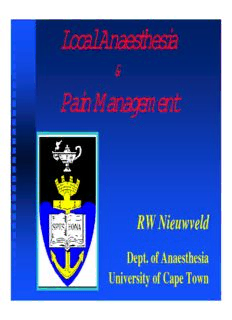
Local Anaesthesia & Pain Management PDF
Preview Local Anaesthesia & Pain Management
Local Anaesthesia & Pain Management RW Nieuwveld Dept. of Anaesthesia University of Cape Town LLLooocccaaalll AAAnnnaaaeeesssttthhheeesssiiiaaa HHiissttoorryy Pre 1866 - Compression techniques n 1866 - “Freezing” with Ether n 1880 - Ethyl Chloride spray n 1880→84 - COCAINE used by Karl Köller n 1905 - PROCAINE developed n 1943 - LIGNOCAINE synthesised n GGeenneerraall SSttrruuccttuurree –– LLooccaall aannaaeesstthheettiiccss N Unsaturated Intermediate 2 º or 3 º Ring Chain Amine (Lipophilic) (Ester or Amide) (Hydrophilic) GGeenneerraall PPhhaarrmmaaccoollooggyy Ionisation - n Must be Unionised (Lipophilic) to penetrate tissues, but Ionised at the nerve pKa - n pH where Ionised = Unionised Protein binding - n Affects the duration of action MMeecchhaanniissmm ooff aaccttiioonn Numerous theories n + + Main action is at the Na -K ionophore at n the nodes of Ranvier LLooccaall AAnnaaeesstthheettiicc AAggeennttss ESTERS CLINICAL USUAL ONSET DURATION MAXIMUM COMMENTS USES CONCEN DOSE TRATION a) *Infiltration 1% Fast 0,5 - 1 hr 10 mg kg-1 Procaine has marked vasodilator action Procaine *Peripheral 1 - 2% Slow 0,5 - 1 hr ⊂ Adrenaline and is generally used with Adrenaline *Spinal 10% Moderate 0,5 - 1 hr 1:200 000 to prolong its effects. b) *Infiltration 1% Fast 0,5 - 1 hr 11 mg kg-1 Lowest systemic toxicity due to rapid Chloro- *Peripheral 2% Fast 0,5 - 1 hr 14mg kg-1 hydrolysis by plasma cholinesterase. procaine *Epidural 2 - 3% Fast 0,5 - 1 hr ⊂ Adrenaline May be neurotoxic intrathecally, due to low pH or preservative. c) *Topical 2% Slow 0,5 hr 1 mg kg-1 High potency, and high toxicity. Ametho-/ *Spinal 0,5% Fast 2 - 4 hr Tetra- caine d) *Surface 4 - 10% Fast 20 - 30 min 3 mg kg-1 Potent vasoconstrictor. Cocaine Sensitises adrenergic receptors to endogenous & exogenous sympathomimetic amines. May cause addiction. Addition of Adrenaline is redundant and may be harmful. AMIDES CLINICAL USUAL ONSET DURATION MAXIMUM COMMENTS USES CONCEN DOSE TRATION a) *Topical 2 - 10% Fast 0,5 - 1 hr 3 mg kg-1 Remains the most versatile and widely Lignocaine *Infiltration 0,5 - 1% Fast 1 - 2 hr 7 mg kg-1 used local anaesthetic. *Peripheral 1 - 1,5% Fast 1 - 3 hr ⊂ Adrenaline Relatively low systemic toxicity. *Epidural 1 - 2% Fast 1 - 2 hr Rapid onset, moderate potency and *IV block 0,5% Fast Up to 2 hr moderate duration of action. *Spinal 5% Fast 0,5 - 1,5 hr No vasoactive effects. Addition of adrenaline decreases toxicity. Antidysrrhythmic. b) *Infiltration 1 - 2% Moderate 3 mg kg-1 Similar to Lignocaine but lasts longer. Mepivacaine *Peripheral 1 - 1,5% Fast 2 - 3 hr 5 mg kg-1 Duration prolonged with Adrenaline. *Epidural 1 - 2% Fast 1 - 2,5 hr ⊂ Adrenaline Marked accumulative potential and rapid placental transfer. c) *IV block 0,2- 0,5% Max 2 hr 6 mg kg-1 Least toxic amide. Prilocaine *Peripheral 1,5 - 2% Fast 1,5 - 3 hr 9 mg kg-1 Methaemoglobinaemia possible if large *Epidural 1 - 3% Fast 1 - 2,5 hr ⊂ Adrenaline doses used. ( > 600 mg) d) *Peripheral 0,5 - 1% Fast 3 - 12 hr 5 mg kg-1 Profound motor block. Etidocaine *Epidural 1 - 1,5% Fast 2 - 4 hr ⊂ Adrenaline e) *Infiltration 0,2 - 0,5% Slow 4 - 12 hr 2 mg kg-1 Does not cause vasodilatation at site of Bupivacaine *Peripheral 0,2 - 0,5% Moderate 4 - 12 hr injection, therefore only modest increase *Epidural 0,2 - 0,5% Fast 2 - 4 hr in duration of action with Adrenaline. *Spinal 0,5% Fast 2 - 4 hr Popular due to:- Potency (3 - 4 x > than Lignocaine.) Relatively low toxicity. Long duration of action. Relatively safe in obstetrics. Exaggerated cardiotoxicity with intra- venous injection. Low concentrations produce a chiefly sensory block. Not used in Bier's (IV) block. f) *Infiltration 0,2 - 1% Slow 4 - 12 hr 3 mg kg-1 New amide local anaesthetic prepared Ropivacaine *Peripheral 0,2 - 1% Fast 2 - 4 hr as a pure S-isomer in contrast to others, *Epidural 0,2 - 1% Fast 2 - 4 hr which are racemic mixtures Recently released in RSA. Not yet Similar to Bupivacaine in onset, potency released for and duration, with less motor block. *Spinal pKa = Bupivacaine. = 8,1. Less cardiotoxic than Bupivacaine, but still has dysrrhythmic potential. TTooxxiicciittyy May occur if a) Too much is given n b) Rapidly absorbed c) Inadvertently injected IV Organ systems involved are the a) CNS n and b) CVS Hypersensitivity n Rare with Amino-amides but may occur with Amino-esters DDuurraattiioonn ooff EEffffeecctt Determined by removal from the nerve n Affected by a) - Perfusion b) - Blood concentration Perfusion modified by Vasoconstrictors v Concentration dependent on Metabolism v Amides - Liver metabolism Esters - Cholinesterase metabolism in blood & liver
Description: